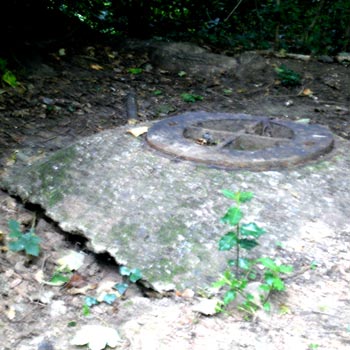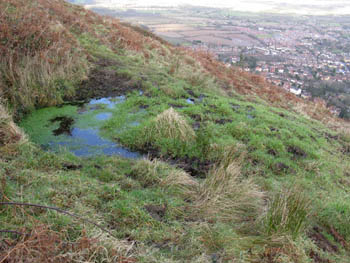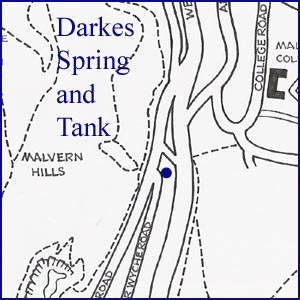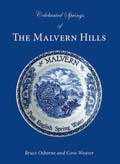
| 
|


Darkes Spring and Tank and Wide Valley Spring
NGR 77440 44899
Site Number: C91
By Bruce Osborne and Cora Weaver (C) 2012
Area 4. West Malvern Springs and Wells
Malvern Hills, England
Description: a substantial underground facility that provided a head of water for a local water supply.
Born in Worcester, James Darke (1801-89) became a Licentiate of the Society of Apothecaries (London) and a medical analyst. He became a medical officer at the Southport Hydropathic Hospital before moving to Malvern where he was an assistant to Dr Gully. By the mid-1860s he was living in West Malvern and treating patients at his baths in West Villa, but by 1868 could be consulted at his rooms at Dr Grindrod's Townshend House, or would see patients in their own homes. As late as 1872, and by then in his 70s, he was still practising, advertising for work in the Malvern Advertiser.
Towards the end of 1866 Mr Darke moved to newly-built South End Villa, sometimes known as Southend Cottage, at the southern extremity of the town on the junction of Lower Wyche Road and Wyche Road. In the garden, on the 700ft contour, was a prolific source of hills water that became known as Darke's Spring.
 to the collector cistern. It is thought that during the 1860s, when the toll house was demolished and the town was busily increasing in population, that the Local Board built a red-brick, 10,000-gallon tank, below South End Villa, to catch the water and pipe it to the town. The tank's elevation meant that it could supply the town with water without needing to be pumped.
to the collector cistern. It is thought that during the 1860s, when the toll house was demolished and the town was busily increasing in population, that the Local Board built a red-brick, 10,000-gallon tank, below South End Villa, to catch the water and pipe it to the town. The tank's elevation meant that it could supply the town with water without needing to be pumped. By the 1870s much of Darke's Spring was running uselessly to waste[1] so in 1879 James Atkins, of Ellerslie House, sensibly applied to put in a 4-inch pipe, 2ft deep, to divert the waste water from both Darke's Tank and the Ellerslie Fountain to his property. With Darke's Spring running to waste, year after year of summer water shortages, and much dithering about what should be done, two wells were dug on Malvern Common, a few yards north-east of the pond on the east side of the road in Malvern Wells, and a pumping station built over the top. It was originally suggested that the water from the two wells should be pumped through a 4-inch pipe up to Darke's tank and from there piped into town. Pumping began early in 1882, filling Darke's Tank at the rate of 5,100 gallons an hour. The Local Board immediately wished they had stuck to the original suggestion and not economised with a 3-inch pipe.
After his wife died, in the 1870s, James Darke spent his retirement in Bellers Lane but became infirm and moved to North Malvern, where he died in May 1889 aged 88 years. For some years he had been a senior deacon at Holly Mount Congregational Church and his obituary described him as 'a good man, eminently pious, of blameless life and exalted reputation.'[2] South End Villa was eventually demolished and a new house, Braeside, built on the site.
1. Darkes Tank lies in the trees above Cherbourg House and is fed by spring water.
2. Water seeps from the leaking and decayed system.
3. The interior of the more modern lower chamber.
The highest issue of Darkes Spring is at 77043 45018 at 1156 feet elevation in the Wide Valley. It has been erroneously named the Watson Spring. [3]
Footnotes:
[1] Malvern Advertiser, 1 Dec 1877.
[2] Malvern Advertiser, 18 May 1889.

[3] Malvern Advertiser 14 Oct. 2011, p.17.
The map alongside is a small section of our more comprehensive map of the area. For the complete map together with a description and history of this site see "Celebrated Springs of the Malvern Hills" (2012).
Website: Click Here
SUPPLEMENTARY INFORMATION

Celebrated Springs of
THE MALVERN HILLS
 A definitive work that is the culmination of 20 years researching the springs and wells of the Malvern Hills, published by Phillimore. This is the ideal explorers guide enabling the reader to discover the location and often the astounding and long forgotten history of over 130 celebrated springs and wells sites around the Malvern Hills. The book is hard back with dust cover, large quarto size with lavish illustrations and extended text. Celebrated Springs contains about 200 illustrations and well researched text over a similar number of pages, together with seven area maps to guide the explorer to the locations around the Malvern Hills. It also includes details on the long history of bottling water in the Malvern Hills.
A definitive work that is the culmination of 20 years researching the springs and wells of the Malvern Hills, published by Phillimore. This is the ideal explorers guide enabling the reader to discover the location and often the astounding and long forgotten history of over 130 celebrated springs and wells sites around the Malvern Hills. The book is hard back with dust cover, large quarto size with lavish illustrations and extended text. Celebrated Springs contains about 200 illustrations and well researched text over a similar number of pages, together with seven area maps to guide the explorer to the locations around the Malvern Hills. It also includes details on the long history of bottling water in the Malvern Hills.
Written by Bruce Osborne and Cora Weaver, this book is available on-line for £15.00 (delivered UK) - click Malvern Bookshop on the green panel top left. Alternatively send a cheque payable to Cora Weaver with your name and address to 4 Hall Green, Malvern, Worcs. WR14 3QX.
1) TOPOGRAPHICAL LOCATION:
Malvern Hills - arguably Britain's original National Park
2) LANDSCAPE:
Built Up Location3) INFORMATION CATEGORY:
A Spring, Spout, Fountain or Holy Well SiteIndustrial Archaeology
4) MALVERN SPRING OR WELL SITE DETAILS:
Site with Malvern Water3 SPLASHES - Of Moderate Interest

5) GENERAL VISITOR INFORMATION:
Access On FootFree Parking Nearby
Accessible All Year


